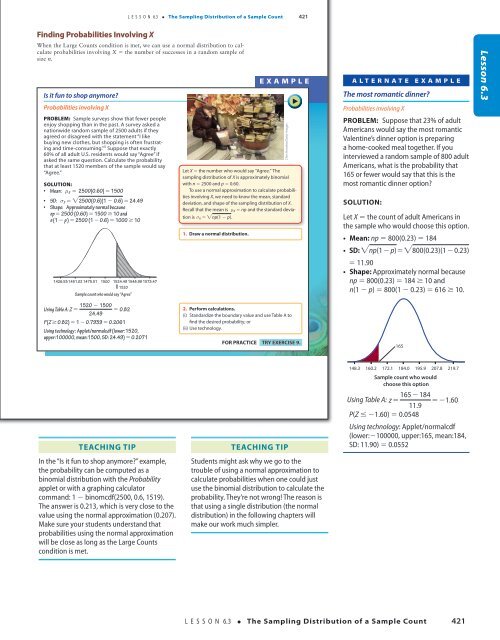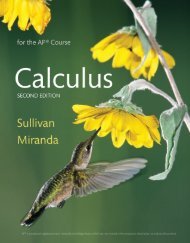SPA 3e_ Teachers Edition _ Ch 6
Create successful ePaper yourself
Turn your PDF publications into a flip-book with our unique Google optimized e-Paper software.
L E S S O N 6.3 • The Sampling Distribution of a Sample Count<br />
421<br />
Finding Probabilities Involving X<br />
When the Large Counts condition is met, we can use a normal distribution to calculate<br />
probabilities involving X 5 the number of successes in a random sample of<br />
size n.<br />
Is it fun to shop anymore?<br />
Probabilities involving X<br />
PROBLEM: Sample surveys show that fewer people<br />
enjoy shopping than in the past. A survey asked a<br />
nationwide random sample of 2500 adults if they<br />
agreed or disagreed with the statement “I like<br />
buying new clothes, but shopping is often frustrating<br />
and time-consuming.” 5 Suppose that exactly<br />
60% of all adult U.S. residents would say “Agree” if<br />
asked the same question. Calculate the probability<br />
that at least 1520 members of the sample would say<br />
“Agree.”<br />
SOLUTION:<br />
• Mean: m X 5 2500(0.60) 5 1500<br />
• SD: s X = "2500(0.6)(1 − 0.6) 5 24.49<br />
• Shape: Approximately normal because<br />
np 5 2500 (0.60) 5 1500 ≥ 10 and<br />
n (1 2 p ) 5 2500 (1 2 0.6) 5 1000 ≥ 10<br />
1426.53 1451.02 1475.51 1500 1524.49 1548.98 1573.47<br />
1520<br />
Sample count who would say “Agree”<br />
1520 − 1500<br />
Using Table A: Z = = 0.82<br />
24.49<br />
P (Z ≥ 0.82) 5 1 2 0.7939 5 0.2061<br />
Using technology : Applet/normalcdf (lower:1520,<br />
upper:100000, mean:1500, SD: 24.49) 5 0.2071<br />
e XAMPLe<br />
Let X 5 the number who would say “Agree.” The<br />
sampling distribution of X is approximately binomial<br />
with n 5 2500 and p 5 0.60.<br />
To use a normal approximation to calculate probabilities<br />
involving X, we need to know the mean, standard<br />
deviation, and shape of the sampling distribution of X.<br />
Recall that the mean is m X = np and the standard deviation<br />
is s X = "np(1 − p).<br />
1. Draw a normal distribution.<br />
2. Perform calculations.<br />
(i) Standardize the boundary value and use Table A to<br />
find the desired probability; or<br />
(ii) Use technology.<br />
FOR PRACTICE TRY EXERCISE 9.<br />
<strong>Ch</strong>ris Hondros/Getty Images<br />
Alternate Example<br />
The most romantic dinner?<br />
Probabilities involving X<br />
PROBLEM: Suppose that 23% of adult<br />
Americans would say the most romantic<br />
Valentine’s dinner option is preparing<br />
a home-cooked meal together. If you<br />
interviewed a random sample of 800 adult<br />
Americans, what is the probability that<br />
165 or fewer would say that this is the<br />
most romantic dinner option?<br />
SOLUTION:<br />
Let X 5 the count of adult Americans in<br />
the sample who would choose this option.<br />
• Mean: np 5 800(0.23) 5 184<br />
• SD: "np(1 − p)= "800(0.23)(1 − 0.23)<br />
= 11.90<br />
• Shape: Approximately normal because<br />
np 5 800(0.23) 5 184 ≥ 10 and<br />
n(1 2 p) 5 800(1 2 0.23) 5 616 ≥ 10.<br />
165<br />
Lesson 6.3<br />
18/08/16 5:01 PMStarnes_<strong>3e</strong>_CH06_398-449_Final.indd 421<br />
Teaching Tip<br />
In the “Is it fun to shop anymore?” example,<br />
the probability can be computed as a<br />
binomial distribution with the Probability<br />
applet or with a graphing calculator<br />
command: 1 2 binomcdf(2500, 0.6, 1519).<br />
The answer is 0.213, which is very close to the<br />
value using the normal approximation (0.207).<br />
Make sure your students understand that<br />
probabilities using the normal approximation<br />
will be close as long as the Large Counts<br />
condition is met.<br />
Teaching Tip<br />
18/08/16 5:01 PM<br />
Students might ask why we go to the<br />
trouble of using a normal approximation to<br />
calculate probabilities when one could just<br />
use the binomial distribution to calculate the<br />
probability. They’re not wrong! The reason is<br />
that using a single distribution (the normal<br />
distribution) in the following chapters will<br />
make our work much simpler.<br />
148.3 160.2 172.1 184.0 195.9 207.8 219.7<br />
Sample count who would<br />
choose this option<br />
165 − 184<br />
Using Table A: z = = −1.60<br />
11.9<br />
P(Z ≤ 21.60) 5 0.0548<br />
Using technology: Applet/normalcdf<br />
(lower:2100000, upper:165, mean:184,<br />
SD: 11.90) 5 0.0552<br />
L E S S O N 6.3 • The Sampling Distribution of a Sample Count 421<br />
Starnes_<strong>3e</strong>_ATE_CH06_398-449_v3.indd 421<br />
11/01/17 3:55 PM




